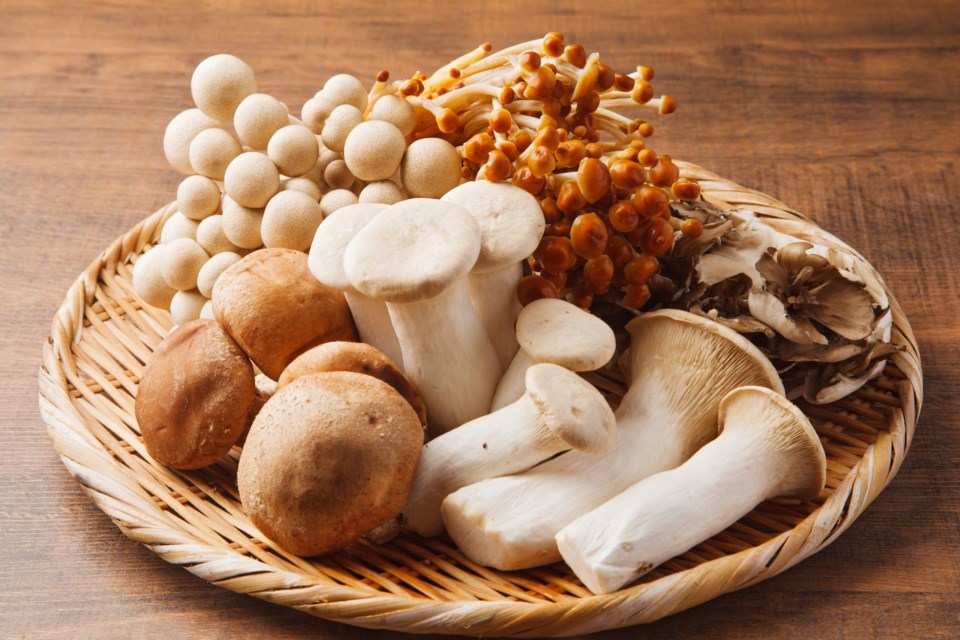Cool, fall temperatures. Frequent rain. It’s fungi season. Fungi walks, fungi talks, fungi demonstrations, fungi festivals, fungi dinners — there are many opportunities at this time of year to learn about our neighbourhood mushrooms.
And mushrooms are appearing throughout the neighbourhood. In one nearby streetside flowerbed, chanterelles have pushed out of the soil. Another yard contains a few mushrooms that look like they might be pine mushrooms — I’d need an expert to confirm the identification. Local lawns — green and luxuriant once again after months of watering restrictions — host tiny toadstools, fairy rings and patches of pointy-topped gilled mushrooms that look suspiciously like death-cap mushrooms.
Mushrooms are also sprouting in the region’s parks and green spaces. A particularly fertile patch has appeared near one of the Mount Douglas Park car parks. I noticed what may be honey and oyster mushrooms growing on dead trees along one of the wilder trails in Francis King Park.
Technically, what we call “mushrooms” are the fleshy, above-ground fruiting bodies that some kinds of fungi produce. Truffles, which develop underground, don’t fit this definition.
But the distinction becomes mushy-edged. “Mushroom” is also used as an umbrella term to encompass many varieties of fungi. For example, the online atlas of B.C. plants includes a discussion of macrofungi — “the larger fungi that we know as mushrooms” — and lumps truffles in among those mushrooms. (Further cause for confusion: fungi are not plants. They belong to their own kingdom of organisms, and are actually more closely related to animals than to plants. Anyway.)
It might seem a piddling matter, but lack of precision in language can open the door to confusion in the field — where confusion and lack of precision can be deadly. When it comes to mushrooms as food, there’s little room for error.
Mushroom scientists estimate that anywhere from 5,000 to 10,000 mushroom species grow in B.C. That’s quite a range of uncertainty.
More than 1,600 species have been confirmed in the province. Hundreds of other species that are found in Oregon, Washington and Alaska have yet to be officially recorded here in B.C. but would probably turn up if somebody went looking for them. Numerous other species not yet named or identified as a species new to science also likely grow in the province.
And here we run into another distinction. Unlike people in many other parts of the world, Canadians as a whole tend not to be particularly interested in hunting our woods and meadows for tasty fungus gems to serve for dinner. Apart from a few hobbyists and enthusiasts and those who pick and sell wild mushrooms for a living, we confine our mushroom hunting to the local grocery store or specialty food market.
Most of us can identify a mushroom as a, well, a mushroom. Beyond that, we’re pretty much clueless as to whether it is a) safe and b) tasty to eat.
Perhaps we’re too well-fed and pampered to feel the need to seek out wild foods and fill the freezer and pantry with our pickings. We haven’t had centuries of intermittent famine to force us to develop abiding foraging traditions or learn in detail all the potential food resources growing wild on our doorstep. Few of us live a subsistence existence where one bad harvest is enough to push us out the door and out of our comfort zones to seek any free food that our forests may offer — just to survive.
Without that need, we don’t need to know what grows in the back 40. Without that, a family tradition of hunting for mushrooms or truffles every fall hasn’t developed.
It’s good to have a history that isn’t shaped by starvation and food insecurity.
But one consequence of that privilege is that the fungi of B.C. are still not fully known, understood and documented. Another is that relatively few of us have tasted a fresh-picked, wild, native-to-B.C. mushroom. Both of those consequences make us poorer scientifically and culturally.
And some people would say that’s OK, too. After all, it means more mushrooms waiting out there in the woods for them to find and enjoy.
- Monique Keiran, Times Colonist


